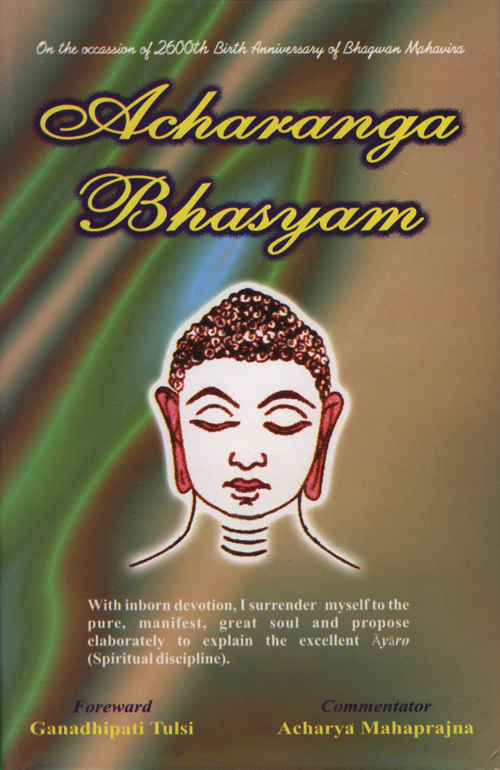5.99 uṭṭhiyassa ṭhiyassa gatiṃ samaṇupāsaha.
Look at the status of the monk who is spiritually awakened and strongly established in self-restraint.
Bhāṣyaṃ Sūtra 99
You should properly look at the state, status, and the designation of the person who has risen up[1] through right exertion and is well established in the community of the preceptor. While staying in the community of the preceptor, there grows in him the competence for scriptural knowledge, steadiness in faith and unwavering state of spiritual practice.
5.100 etthavi balabhave appaṇaṃ ṇo uvadaṃsejja.
Do not succumb to the state of the ignorant who does not find any fault in violence.
Bhāṣyaṃ Sūtra 100
Here in respect of violence, there is immatured inclinations of some thinkers who think that, as there is no conflagration or hole in the sky (space), similarly there is no conflagration or hole in the soul. The soul is as eternal as the space, and therefore injury to life is quite impossible'. One should not leave oneself in such perversity. One should not support violence on the plea of the eternality of the soul. On the contrary, the monk should address the people indulging in violence in the following way.
5.101 tumaṃsi nāma sacceva jaṃ 'haṃtavvaṃ' ti mannasi, tumaṃsi nāma sacceva jaṃ 'ajjāveyavvaṃ' ti mannasi, tumaṃsi nāma sacceva jaṃ 'paritāveyavvaṃ' ti mannasi, tumaṃsi nāma sacceva jaṃ 'parighetavvaṃ' ti mannasi. tumaṃsi nāma sacceva jaṃ 'uddaveyavvaṃ' ti mannasi.
You are indeed he whom you intend to hurt.
You are indeed he who, you intend to govern.
You are indeed he who, you intend to torture.
You are indeed he who, you intend to enslave.
You are indeed he who, you intend to kill.
Bhāṣyaṃ Sūtra 101
'You are indeed the person whom you consider to be worthy of being killed'. In this way the non-duality of the self as the killer and the killed is established. 'The person whom you are torturing is non-else than yourself. And therefore do you not kill yourself while you think you are killing somebody else?' Through an appreciation of such non-duality of the killer and the killed the abstinence from violence becomes the nature of oneself. Where there is the experience of duality or the experience of otherness with oneself, there is the contingency of killing and the like. In this way, the instruction is given about the non-duality, that is the nature of the self. Such explanation is applicable to the acts of commanding, torturing etc.
5.102 aṃjū ceya-paḍubuddha-jῑvῑ, tamhā ṇa haṃtā ṇa vighāyae.
The wise person leads a simple and righteous life with proper understanding, so he does not indulge in hurting or get anybody hurt by others.
Bhāṣyaṃ Sūtra 102
The non-violent person is simple and righteous. He leads the life, fully realizing the identity between killer and the killed. He does not accept this principle out of fear or conceit. This is the reason why he does not kill creatures or get them killed by others.
5.103 aṇusaṃveyaṇamappāṇeṇaṃ, jaṃ 'haṃtavvaṃ' ti ṇābhipatthae.
One has to suffer the consequences of his own deeds; so do not wish to hurt others.
Bhāṣyaṃ Sūtra 103
'You have to enjoy the result of your own karma'. This is called the 'consequential enjoyment' by oneself. It has been said in the Cūrṇi (p. 194) that you have to feel as you made others to feel. Therefore, one should not wish that any creature should be killed.[2]
(a) Ācārāṅga Cūrṇi, p. 193: uṭṭhitassa gurukule vasaṃto gatiṃ samaṇupassaha, kiṃgatiṃ gato? jahā koyi rāyasevago rāyāṇaṃ ārahittā paṭṭabaṃdhaṃ patto, tattha loe vattāro bhavaṃti - peha amugo kaṃ gatiṃ gao? evaṃ abbhiṃtaraissariyattaṇeṇa mahāvijjāe vā, iha hi āyariyakulāvāse vasaṃto 'ṇīyaṃ sejjaṃ gatiṃ thāṇaṃ ṇiyamā (ṇīyaṃ ca ā) saṇāṇi yā' evaṃ vaṭṭamāṇo 'pūjjā ya se pasīyaṃti, saṃbuddhā puvvasaṃthutā. so acirayakāleṇa āyariyuapadaṃ pāvati paṭṭabaṃdhaṭhāṇῑyaṃ, ato vuccati - uṭṭhitassa ṭṭhitassa, annāovi riddhio pāvaṃti, siddhigatiṃ devalogaṃ vā'.
(b) Ācārāṅga Vṛtti, patra 203: utthitasya niḥśaṃkasya śraddhāvataḥ sthitasya gurukule gurorājñāyāṃ vā yā gatirbhavati, yā padavī bhavati.
 Acharya Mahaprajna
Acharya Mahaprajna

